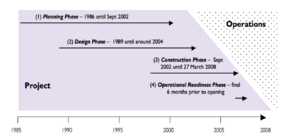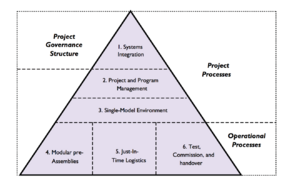Heathrow Terminal 5
Contents |
Abstract
The Heathrow terminal 5 (T5) project was created with the intent of easing the congestion of the airport, centralizing all British Airways flights, and increasing the revenue from other airlines. Due to the size of the project both in size and budget it was complex to manage, this was not ameliorated by the fact that it took eight years to get government approval. The project consisted of a control tower, two satellite buildings, and supporting infrastructure. The latter included river diversions, connections between terminals, and a train station. This resulted in 16 major projects, and 147 sub-projects, all separate from each other and involving over 60 contractors in total. [1] Due to the fact that construction projects by nature are prone to delays it’s quite remarkable that Terminal 5 was completed on time, within budget, and with less fatalities than expected. The reason for this was the fact that the contracts between British Airways and the contractors were quite unique for at time. The contracts were unique because all contractors pooled together risk payments and were promised a share in the event that their work was finished on time. This proved to be an effective incentive not only to be on time and on budget, but also to nudge the contractors towards better teamwork as the prospects of getting the bonuses was higher than way. The result was a construction project finished on time and on budget with fewer fatalities than there would normally be on a project of that size. Unfortunately there were issues on the operation level that led to bad reviews on the opening week that overshadowed the success of the construction project. [2]
Overview
T5 project is considered a mega project; due to the fact that these are "projects of a significant cost that attract a high level of public attention or political interest because of substantial direct and indirect impacts on the community, environment, and budgets". [3] The client and owner of Heathrow Airport, and by extension T5, in this case is BAA. In this article only one of the contractors will be singled out; Lain O’Rouke. This is due to the fact that LOR grew with the project in such a way that it has completely changed the shape of the organization today.
Phases of T5 project
The T5 project in question can be divided into 4 phases shown in figure 1. It should be noted that the planning phase contains a 4-year long period of inquiry (1995-1999) and subsequent "consent to proceed with construction"[4]. in 2001. The T5 project is one of the longest in British history and cost around £80, cementing its label as a mega project.
Planning phase
In 1990 Sir John Egan became the CEO of BAA and would continue to work through 1999. He had previously worked for Jaguar, a company that seemed to be very close to shutting down, but he turned the trend and is largely credited for the success. Egan used his knowledge about Lean production from the automobile industry and attempted to apply it the construction of T5. Furthermore he recognized that projects are often unique and therefore approached as a "blank slate"[4], as BAA did prior to his arrival. In an effort to ameliorate this he wanted to create standardized parts of projects in an effort to apply Lean principles, that emphasized simplification and standardized tasks.
Egan gathered a team to explore practices, principles, and technologies from different industries in an effort to see what would work in the T5 project. Later on he would establish an organization that worked independently from BAA in an effort to "provide the freedom of choice needed to promote experimentation and innovation"[4]. Later on BAA would establish a Continuous Improvement Project Process (CIPP) in an effort to "provide a set of standardized and repeatable time-sequenced tasks, milestones, and stage-gates to deliver cost-effective and profitable projects"[4]. The projects in question would have a budget between $4M-$8M. CIPP also looked into the design process by working with modular design, so that the construction processes would have similar construction processes, despite being vastly similar. This was not done with the sole intent to apply these processes to T5, but for capital projects. Furthermore it gave BAA knowledge about suppliers’ capabilities, which was used in T5.
Hierarchical model of project processes
The processes of a mega project have been developed into a hierarchical model seen in figure 2 [4]. In the T5 project BAA was the systems integrator and thereby responsible for all management and coordination throughout the project.
Research of pitfalls from similar projects
BAA approached this responsibility by starting with research into similar projects. These were divided into two categories: construction projects in the UK with a budget over $2B and all airport constructions in the world. The timeframes were 10 years and 15 years respectively. This enabled the research team to recognize problem areas and look for efforts to improve them.
The research showed that no major projects in the UK or international airports had been completed and successfully accomplished any goals pertaining to time, budget, quality, and safety. The research on airports around the world proved no better, but gave a numerical estimate of how much the T5 project could be over budget etc. On the other hand the team divided the problem areas into two areas: "lack of collaboration among project partners; and clients’ reluctance to assume responsibility for project risks."[4] Furthermore, the first Project Director of T5 noted that most projects failed due to a lack of sufficient funding of the design phase.
Project processes
These processes nicely complement each other to form a foundation of organization and management throughout the project. First of all the T5 legal agreement was created in order to bind all parties to a structured workflow of specific tasks and tools. Moreover it serves as an aid throughout all phases of the project. The challenge of T5 was that it had a lot of contractors and was dependent on lots of technologies that BAA was not intimately familiar with. This was ameliorated by the fact that the BAA (in this case: the client and systems integrator) assumed all responsibility of risks and gave the contractors an incentive to work together. More importantly, a single-model environment (SME) enabled coordination throughout phases and across design disciplines. This is due to the fact that multiple users can share designs and the SME will detect any clashes. This decreases the risk of mistakes in the design phase that could potentially be found out during the construction phase. These types of mistakes are costly due to the fact that they inhibit the project moving along thus creating chaos. Solutions to these types of mistakes are often not completely thought out due to the fact that they are created in a hurry and don’t undergo the same process as all the other decisions. Adding to this, SME enables design disciplines to create a construction that is favorable during the operation as well. This could be by adding enough space to make it easier for the person doing the electrical repairs to actually see what’s going on without e.g. visual aids due to the space being too small. Lastly SME is a great tool during the planning phase as it is an visual aid of the construction site and it’s entries, walkways, exists. This will be detailed further during the construction phase. Tying this all together its crucial to incorporate project and program management processes as these manage both the main project, which is T5, but also all the sub-projects.
Stakeholders
Construction and Performance Management
Opening and Operational Management
References
- ↑ [http://www.airport-technology.com/projects/heathrow5/] London Heathrow Airport Expansions (LHA/EGLL), United Kingdom
- ↑ [http://www.the-chiefexecutive.com/features/feature68469/] 'Why stakeholders matter
- ↑ [http://flyvbjerg.plan.aau.dk/whatisamegaproject.php] What is a Megaproject?
- ↑ 4.0 4.1 4.2 4.3 4.4 4.5 Andrew Davies, David Gann,Tony Douglas"> Innovations in Megaprojects: Systems Integration At London Heathrow Terminal, California Management Review, 2009

